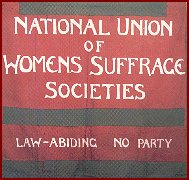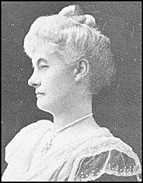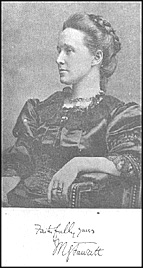[This document comes from Helena Wojtczak's English Social History: Women of Nineteenth-Century Hastings and St. Leonards. An Illustrated Historical Miscellany, which the author has graciously shared with readers of the Victorian Web. The images have been taken from other sources, as specified, and a note and bibliography have been added. Click on the title to obtain the original site, which has additional information.]

In 1868, after the Kensington Society's amendment to the Reform Act to give votes to women failed, it formed the London Society for Women's Suffrage. A Hastings branch opened later, with Miss Fricker Hall, head of Bonham House Girls' Collegiate school, Pevensey Road, as secretary. The inaugural meeting was attended by 'new woman' Sarah Grand, and the branch boasted Barbara Bodichon, polymath Dr Anna Kingsford and novelist Olive Schreiner among its membership. Meetings generally drew over a hundred attendees. This group was later dissolved and was reformed in 1909 as a branch of the NUWSS.
The WSPU was responsible for the massive increase in NUWSS membership: WSPU militancy drew publicity, and those who could not, or would not, join the militants turned instead to the NUWSS, which was always non-violent and announced its intention to continue its ancient and ineffective policy of campaigning for the vote using purely constitutional means. By 1914 the NUWSS had over 500 branches and 100,000 members.

The Hastings NUWSS President was Sybil, Countess Brassey (pictured, right); her husband, philanthropist Earl Brassey, gave speeches in support. At the Public Hall in November 1911 he shared a platform with the society's longstanding national leader Millicent Garratt Fawcett [whose account of the formation of the society is among the government papers — see bibliography], and Earl Lytton. Although the hall accommodated 700, overcrowding was so severe that an 'overspill' meeting had swiftly to be arranged in the basement assembly rooms.
Among the members of Hastings branch were Miss Marchant, schoolmistress; Mrs F C Tubbs; Mrs Harloe Phibbs; Mrs and Miss Pelly; Miss Kirk-Bullock; Miss Sidney; and Mrs PS Barlow. Miss Jane E Strickland was one of only two ladies on the Education Committee, to which she had been appointed in 1890. After the vote was won, she became a magistrate. Previously a liberal, she turned socialist and was vice-chair of Hastings Labour Party.

While the NUWSS gained members as a result of WSPU militancy and publicity stunts, by the same token it sometimes got the blame for damage. After suffragettes burned down the MP's mansion, Levetleigh in 1913, a group of furious men set upon the NUWSS headquarters at 7 Havelock Road, Hastings (pictured, below). The attack turned into a street riot.
When in February 1918 female householders aged over 30 were granted the vote, NUWSS national leader Millicent Fawcett, wrote in her diary: 'It is almost exactly 61 years ago since I heard John Stuart Mill introduce his suffrage amendment to the Reform Bill on May 20th, 1867. So I have had extraordinary good luck in having seen the struggle from the beginning.'
Mrs Fawcett lived to see the vote was extended to women on the same terms as men, in 1928. She died the following year.
Link to Related Matyerial
Bibliography
UNESCO Women's Suffrage Documents. UK Parliament. Web. 4 September 2023.
Created Last modified 2000